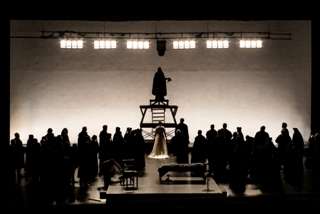|
Back
The Martyred Queen and the “Bastarda” Lisboa
Teatro Nacional de São Carlos
01/25/2020 - & January 27, 29, 31, February 2, 2020
Gaetano Donizetti: Maria Stuarda
Alessandra Volpe (Elisabetta), Ekaterina Bakanova (Maria Stuarda), Leonardo Cortellazzi (Leicester), Luís Rodrigues (Talbot), Christian Luján (Cecil), Rita Marques (Anna Marques)
Coro do Teatro Nacional de São Carlos, Giovanni Andreoli (chorus master), Orquestra Sinfónica Portuguesa, Fabrizio Maria Carminati (conductor)
Andrea De Rosa (stage director), Sergio Tramonti (sets), Ursula Patzak (costumes), Pasquale Mari (lighting)

(© Susana Chicó)
Bel Canto fans, myself included, are fond of Donizetti’s Maria Stuarda despite its fictitious libretto and some tedious musical passages. The main reason is the larger than life characters of the two Queens, Mary Queen of Scots and Elizabeth I. Based on Andrea Maffei’s translation of Schiller’s play, Maria Stuarda has as an apocryphal confrontation between the two queens at its centre. That confrontation scene requires two grand singing actresses. Both Russian soprano Ekaterina Bakanova and Italian mezzo Alessandra Volpe were definitely up to the task. “Figlia impura di Bolena” (“Impure daughter of Boleyn”) is the pivotal phrase in this scene, uttered by Mary Stuart as she is provoked by Elizabeth at the end of Act I. Bakanova has enough fury in her phrasing, yet manages to remain regal despite the obscenity. However, her phrasing of “Profanato è il soglio inglese, vil bastarda, dal tuo piè!” (“England’s throne is profaned by you, vile bastard”) effectively sent shivers down one’s spine. The role of Elizabeth is tricky as she has to restrain herself vocally and dramatically not to outstage Mary, and Volpe managed that effectively. With her warm mezzo and excellent stage presence, she was an ideal Elizabeth. Despite an armoured front, she managed to reveal her fragility in the scenes involving her jealousy over Leicester and her insecurity vis-à-vis the younger and more attractive Mary. Her interpretation of the opening aria “Sì, vuol di Francia il Rege” was first rate, aptly expressing her uncertainty “Ah quando all’ara scorgemi” and insecurity “Ah, dal ciel discenda”. Ekaterina Bakanova, endowed with a brilliant yet incisive coloratura, was ideally cast in the role of Mary. Moreover, her good looks, natural elegance and stage presence insured a truly regal Maria Stuarda. The final scene, the opera’s strongest moment, was overwhelming. As she learns of her impending beheading, Mary sings a moving prayer “Deh! Tu di un umile preghiera il suono odi” where through vocal expressiveness, beautiful phrasing and an impressive final high note, she completely subjugated the public. She further moved with the shattering finale “Ah! d’un cuor che muore reca il perdon, ah! dal rimorso non sia punita, tutto col sangue cancellerò” where she again conveyed a true regal character.
Italian tenor Leonardo Cortellazzi was a vocally appealing Leicester, but his acting was not as great as his singing. Luís Rodrigues was a dignified Talbot. Despite a sturdy voice and convincing acting, he could not save the musically feeble second scene of the second act. Italian conductor Fabrizio Maria Carminati led the Orquestra Sinfónica Portuguesa with panache, always varying the tempo to suit the singers’ needs.
To appreciate Maria Stuarda, one has to understand that it was written from a continental (Catholic) perspective that is very different from the Anglo-Protestant view most English speakers are familiar with. Elizabeth I is not seen as “Good Queen Bess” but the bastard child of Henry VIII and Ann Boleyn, as the king’s marriage to Catherine of Aragon had not been annulled. Mary Queen of Scott, daughter of James V and Marie de Guise, was the legitimate Queen of Scotland, and as the great-niece of Henry VIII, she also had a viable claim to England’s throne. Portrayed as a dignified, proud and angelic woman, Mary was very likely not the latter. She was believed to have conspired with her lover and later spouse Lord Bothwell to murder her first husband and first cousin Henry Stuart.
The Teatro dell’Opera di Roma’s production was effective thanks to its spartan sets. Given Teatro São Carlos deep stage, Sergio Tramonti’s simple sets accentuated the drama. Ursula Patzak’s costumes were appealing, especially the two queens’s elegant and contrasting dresses. The courtiers’s black costumes were appropriately sombre. This was especially effective when the courtiers encircle Mary during the Act I confrontation scene. Usually, Mary and Elizabeth are alone on stage during much of this scene, but the stage director’s choice of having Elizabeth publicly humiliate Mary further victimizes the Scottish Queen. Mary’s public retaliation further dooms her fate. Pasquale Mari’s intelligent dim lighting by candelabras was used to stress bleakness, tension and confinement. This was most striking at Mary’s prison at Fotheringay Castle: the sparse lighting of the courtyard and the spot on the marvelously dressed Mary enhanced the imprisoned queen’s aura and made one immediately sympathize with her. Most effective was Ann Kennedy’s gentle dressing of Mary with a white, almost bridal gown, in preparation for her beheading. The further addition of long red gloves made for a more dramatic costume. Unlike some productions, Mary was not executed on stage nor was she led to the scaffold. She just moved towards it with poise and dignity. An appropriately theatrical martyrdom!
Ossama el Naggar
|